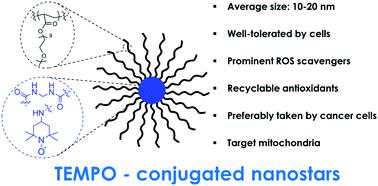当前位置:
X-MOL 学术
›
J. Mater. Chem. B
›
论文详情
Our official English website, www.x-mol.net, welcomes your
feedback! (Note: you will need to create a separate account there.)
Nitroxide-functional PEGylated nanostars arrest cellular oxidative stress and exhibit preferential accumulation in co-cultured breast cancer cells
Journal of Materials Chemistry B ( IF 6.1 ) Pub Date : 2021-08-31 , DOI: 10.1039/d1tb00812a Nam V Dao 1, 2 , Francesca Ercole 1 , Yuhuan Li 1, 3 , Thomas P Davis 1, 4 , Lisa M Kaminskas 5 , Erica K Sloan 6, 7 , John F Quinn 1, 8 , Michael R Whittaker 1
Journal of Materials Chemistry B ( IF 6.1 ) Pub Date : 2021-08-31 , DOI: 10.1039/d1tb00812a Nam V Dao 1, 2 , Francesca Ercole 1 , Yuhuan Li 1, 3 , Thomas P Davis 1, 4 , Lisa M Kaminskas 5 , Erica K Sloan 6, 7 , John F Quinn 1, 8 , Michael R Whittaker 1
Affiliation

|
The limited application of traditional antioxidants to reducing elevated levels of reactive oxygen species (ROS) is potentially due to their lack of stability and biocompatibility when tested in a biological milieu. For instance, the poor biological antioxidant performance of small molecular nitroxides arises from their limited diffusion across cell membranes and their significant side effects when applied at high doses. Herein, we describe the use of nanostructured carriers to improve the antioxidant activity of a typical nitroxide derivative, (2,2,6,6-tetramethylpiperidin-1-yl)oxyl (TEMPO). Polymers with star-shaped structures were synthesised and were further conjugated to TEMPO moieties via amide linkages. The TEMPO-loaded stars have small hydrodynamic sizes (<20 nm), and are better tolerated by cells than free TEMPO in a breast cancer-fibroblast co-culture, a system exhibiting elevated ROS levels. At a well-tolerated concentration, the polymer with the highest TEMPO-loading capacity successfully downregulated ROS production in co-cultured cells (a significant decrease of up to 50% vs. basal ROS levels), which was accompanied by a specific reduction in superoxide anion generation in the mitochondria. In contrast, the equivalent concentration of free TEMPO did not achieve the same outcome. Further investigation showed that the TEMPO-conjugated star polymers can be recycled inside the cells, thus providing longer term scavenging activity. Cell association studies demonstrated that the polymers can be taken up by both cell types in the co-culture, and are found to co-locate with the mitochondria. Interestingly the stars exhibited preferential mitochodria targeting in the co-cultured cancer cells compared to accompanying fibroblasts. The data suggest the potential of TEMPO-conjugated star polymers to arrest oxidative stress for various applications in cancer therapy.
中文翻译:

具有氮氧化物功能的聚乙二醇化纳米星阻止细胞氧化应激并在共培养的乳腺癌细胞中表现出优先积累
传统抗氧化剂在降低活性氧 (ROS) 水平上的有限应用可能是由于它们在生物环境中测试时缺乏稳定性和生物相容性。例如,小分子氮氧化物的生物抗氧化性能较差,这是由于它们在细胞膜上的扩散有限以及在高剂量应用时会产生显着的副作用。在此,我们描述了使用纳米结构载体来提高典型氮氧化物衍生物 (2,2,6,6-四甲基哌啶-1-基)氧基 (TEMPO) 的抗氧化活性。合成了具有星形结构的聚合物,并通过以下方式进一步与 TEMPO 部分共轭酰胺键。加载 TEMPO 的恒星具有较小的流体动力学尺寸(<20 nm),并且在乳腺癌-成纤维细胞共培养中比游离 TEMPO 更能被细胞耐受,该系统表现出升高的 ROS 水平。在耐受良好的浓度下,具有最高 TEMPO 负载能力的聚合物成功地下调了共培养细胞中 ROS 的产生(与基础 ROS 水平),伴随着线粒体中超氧阴离子产生的特异性减少。相比之下,等效浓度的游离 TEMPO 没有达到相同的结果。进一步的研究表明,TEMPO 共轭星形聚合物可以在细胞内循环利用,从而提供更长期的清除活性。细胞关联研究表明,聚合物可以被共培养中的两种细胞类型吸收,并被发现与线粒体共处。有趣的是,与伴随的成纤维细胞相比,这些恒星在共培养的癌细胞中表现出优先的线粒体靶向。数据表明 TEMPO 共轭星形聚合物在癌症治疗中的各种应用中具有阻止氧化应激的潜力。
更新日期:2021-08-31
中文翻译:

具有氮氧化物功能的聚乙二醇化纳米星阻止细胞氧化应激并在共培养的乳腺癌细胞中表现出优先积累
传统抗氧化剂在降低活性氧 (ROS) 水平上的有限应用可能是由于它们在生物环境中测试时缺乏稳定性和生物相容性。例如,小分子氮氧化物的生物抗氧化性能较差,这是由于它们在细胞膜上的扩散有限以及在高剂量应用时会产生显着的副作用。在此,我们描述了使用纳米结构载体来提高典型氮氧化物衍生物 (2,2,6,6-四甲基哌啶-1-基)氧基 (TEMPO) 的抗氧化活性。合成了具有星形结构的聚合物,并通过以下方式进一步与 TEMPO 部分共轭酰胺键。加载 TEMPO 的恒星具有较小的流体动力学尺寸(<20 nm),并且在乳腺癌-成纤维细胞共培养中比游离 TEMPO 更能被细胞耐受,该系统表现出升高的 ROS 水平。在耐受良好的浓度下,具有最高 TEMPO 负载能力的聚合物成功地下调了共培养细胞中 ROS 的产生(与基础 ROS 水平),伴随着线粒体中超氧阴离子产生的特异性减少。相比之下,等效浓度的游离 TEMPO 没有达到相同的结果。进一步的研究表明,TEMPO 共轭星形聚合物可以在细胞内循环利用,从而提供更长期的清除活性。细胞关联研究表明,聚合物可以被共培养中的两种细胞类型吸收,并被发现与线粒体共处。有趣的是,与伴随的成纤维细胞相比,这些恒星在共培养的癌细胞中表现出优先的线粒体靶向。数据表明 TEMPO 共轭星形聚合物在癌症治疗中的各种应用中具有阻止氧化应激的潜力。











































 京公网安备 11010802027423号
京公网安备 11010802027423号